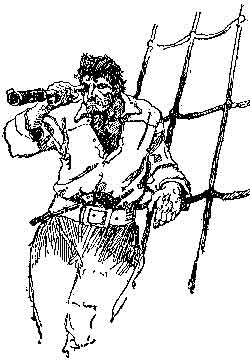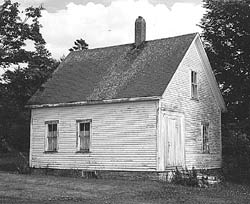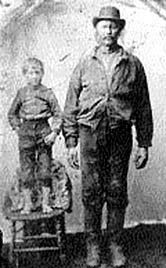
Drawing of Captain Kidd leaning on ratlines. Looking for a place to bury his treasure? (Island Journal, Volume Six.) |
Few places on the coast have as many stories attached to them as the Isles of Shoals. This group of islands is about eight miles off shore on the Maine-New Hampshire border. There are stories of shipwrecks where sailors from warmer climates manage to get to shore but die in snow banks a few feet from homes with fires roaring in the fireplace.
Then there are grisly murder stories, and of course, buried treasure. While murder legends are fairly common along the coast, those with found treasure are not. At least two treasures have been found on the Isles of Shoals, one the traditional black iron pot full of gold and silver coins and another not so conventional.
Though this is not a conventional found treasure story, it is not that surprising either. A lot of privateers, pirates and booty no doubt passed nearby in the 17th and 18th centuries. This story has no mysterious map, midnight trek or ghostly apparitions. The former owner of Smuttynose Island, a Captain Haley, simply turned over a rock one day and found four large silver bars. The proceeds built the breakwater that is still there and a dock in the harbor.
There are no longer houses on the islands, but the ghosts of a few one-time residents are said to have lingered. Legend has it that Blackbeard came to the islands with one of his many wives. They spent their honeymoon on Smuttynose. Blackbeard then boarded his vessel and sailed away after promising to return, but he never did. His wife remained and waited until she died. She had throughout her life scanned the sea for his return. After death, her shadow clothed in flowing garments, has been reported seen at night, by the shore watching for some sign of her husband’s return.
For some places, once they get a name for mystery, the reputation seems to stick. Isles of Shoals is one of these places. Another of its tales is of a ghost ship in the water around the group of islands. According to the legend, many years ago a fisherman from the Isles had a shallop built on the mainland. The proud owner decided to sail her home on Christmas day. His family was on the shore to watch the vessel beat in to her mooring. Dark clouds were gathering, the surf was muffled and heavy, but it seemed certain the small vessel would arrive safely. Suddenly the squall came down with a blast of snow, the boat was driven back out of the harbor and vanished into the driving storm. Three times in the next three days the vessel struggled to get into the bight, but was driven out again. After the third attempt the vessel apparently vanished. However, on some moonlit nights before a storm, a small vessel with ragged sails is seen beating into the haven she will never reach.
Further east, Casco Bay, with its many islands, has plenty of stories of Indian massacres, pirates, treasure and murder. One of these islands, Haskell’s, has an unusual story connected to it. Many years ago two brothers bought the island named after them and ran a saltwater farm with some success. However, perhaps in shipping supplies to the island, rats were introduced and without natural enemies, they multiplied quickly. From being an annoyance they soon were causing havoc, consuming the brothers’ supplies, ruining fish, spoiling grain stores and damaging fruit trees.
The brothers decided to import a couple of cats. They brought over a male and female. The cats found it as easy as the rats had. With plenty of rats the cats multiplied. As the rat population dwindled the cats, too, went after the fish drying on stages, hens and anything else left out.

Tall Barney’s home near Barney’s Cove, Beals Island, Maine. Tall Barney built the house himself in 1873 with the help of his son John, 15 years old at the time. According to Avery Kelley, a great-great grandson of Barney, it was built with lumber that came off a vessel that went ashore. |
Then one of the brothers fell ill and the other went for a doctor. He returned to the horror of finding that his sick brother, unable to defend himself, had been attacked, killed and partially eaten by the ravenous cats.
The treasure of Captain Kidd has generated a lot of interest over the years. The Maine coast was not only on the route to Europe, it had many places where ships could get water, make repairs, plug leaks or hide out. It seems likely that some of these were pirate’s ships, but not real likely that many had stopped to bury a few hundred pounds of gold.
In the case of Captain Kidd, there is documented evidence of his exploits. William Kidd became highly regarded in the British and American merchant marine as a courageous and intelligent officer. For years the English merchant marine had been preyed upon by pirates, with ships sunk and others robbed of their treasure. Much of the piracy was off the east coast of Africa where English ships in the India trade passed. Spanish galleons loaded with Peruvian gold off the coast of South America were also a favorite target.
The English losses became so great that merchants bought and equipped a war vessel. They put it under the command of Captain Kidd to run down the pirates. Since the pirates were known to have taken large amounts of gold, the merchants believed that capturing them may make the operation profitable.
Soon after reaching the east coast of Africa, Kidd sent back reports of the destruction of several vessels and the capture of much treasure. But the treasure seemed only to whet Kidd’s appetite for it and he soon joined the other side. For two years in the late 1690s he was the scourge of the seas. Other pirates and the merchant vessels of any nation were plundered by him. Sailing what looked like a British warship, Kidd was unmistakable. This may have contributed to the scale of his reputation. It would be a bit like robbing banks in a state police car today.
After an extended cruise along the east coast of America as far north as Halifax, Nova Scotia, he inexplicably made a bold entry at the port of Boston. He entered as an English merchant vessel using the papers originally furnished by his English employers.
Shortly after arriving in Boston he was arrested and returned to England. It has been said that a ship Kidd captured and used to replace his aging ship, belonged to an influential merchant who pressed the British for action against Kidd. Further, while privateering (pirating) had been condoned for years by governments when their enemies were the targets, a shift to more legitimate practices was being encouraged by the British at this time.
He was put on trial for piracy and in two days tried, convicted and hanged in May of 1701 at 55 years of age. His wife was allowed to see him only after the death sentence was handed down. During that hushed meeting Kidd was seen to have handed her a card on which he had written the figures 44106818. This card was taken from her by a guard and not returned. The card was alleged to be preserved with the record of the trial.
These figures were believed by some to be the longitude and latitude for the location of the famed treasure. The coordinates are on eastern Deer Isle. This became the basis for a story of Captain Kidd’s treasure written in 1889. In this detailed accounting, Franklin Head claims Kidd’s treasure was found on Deer Isle by Jacob Astor and that it was the basis of the Astor fortunes.

Tall Barney and son. |
Traveling further east to Beals Island there are no pots of gold, but gems of the legend of Tall Barney. What the Isles of Shoals have in ghosts, murder and treasure, Beals has in Tall Barney. Some of the stories are told by people who speak as though they were eyewitnesses to Tall Barney’s exploits. Many in fact are related to Barney via Manwarren Beal, the founding father of the island in 1792 and ancestor of “Tall Barney” Beal. Evidence of the existence of Tall Barney remains in his small house with the big door. Over in Jonesport is Tall Barney’s restaurant.
In a time when most people were close to five feet tall, Barney was by some estimates close to seven. Whether it’s 92 year old Adrian Beal or Barney’s great-great grandson Avery Kelley telling a Tall Barney story, there is something like a documentary style to the presentation. Conversation that goes from the length of their own boat to the age of their house moves easily into the day Tall Barney picked up flour at the grist mill. That is, he picked up a 150-pound flour barrel under each arm to carry to his wagon.
That may sound like a lot of flour, but Tall Barney had an appetite to match his great size. He would eat enormous quantities of food. Of course, at close to 300 pounds he had to eat like that to fuel his great size and strength. A mild mannered man, when provoked under the influence of drink he could whip up a tempest. One story tells of a trip Barney and his fishing partners made to Portland hauling fish. He and the others went to a barroom where they had drinks. A few of the men at the bar made taunting comments about his size or clothes. When challenged by them, he picked the men up one at a time and threw them out the open door, emptying the room.
When hearing these stories, some stumble over the need to analyze them from their own size and weight perspective. But Tall Barney was known to some as a giant. Many who had known him recalled seeing him with palms on the floor, tapping his fingers while seated in a chair. Long arms would have given him considerable edge in a fist fight or getting a grip on a flour barrel. To Barney all furniture was like children’s furniture. His wife made all his clothing since there was nothing large enough for sale.
The death certificate for Barney Beal indicates he died at 63 on February 1, 1899 of a heart problem. The list of his feats of strength is long. It was how he saw himself, the gentle giant who used his strength as a tool. Some thought he may have worn himself out with these almost superhuman feats. The result was to make himself, if not the most, then among the most, legendary figures on the Maine coast.
|





